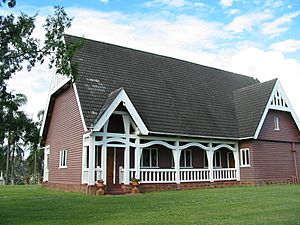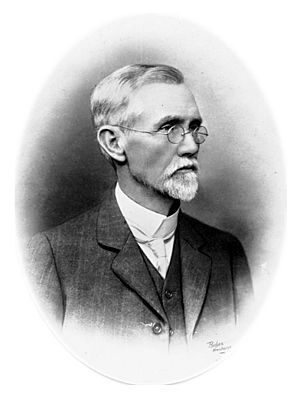All Saints Memorial Church, Tamrookum facts for kids
Quick facts for kids All Saints Memorial Church, Tamrookum |
|
|---|---|

Tamrookum All Saints Anglican Church, 2005
|
|
| Location | Tamrookum Church Road, Tamrookum, Scenic Rim Region, Queensland, Australia |
| Design period | 1914 - 1919 (World War I) |
| Built | 1915 |
| Architect | Robin Dods |
| Official name: All Saints Memorial Church | |
| Type | state heritage (built) |
| Designated | 21 October 1992 |
| Reference no. | 600030 |
| Significant period | 1915 (fabric) |
| Significant components | plaque, trees/plantings, fence/wall - perimeter, graveyard, garden - ornamental/flower, furniture/fittings, gate - entrance, stained glass window/s |
| Lua error in Module:Location_map at line 420: attempt to index field 'wikibase' (a nil value). | |
All Saints Memorial Church is a special historic church located in Tamrookum, a part of the Scenic Rim Region in Queensland, Australia. It was built in 1915 by a family to remember a loved one. The church was designed by the famous architect Robin Dods. Because of its importance, it was added to the Queensland Heritage Register in 1992.
Contents
A Church Built from Love and Memory
This beautiful wooden church was built to honour Robert Martin Collins, who lived from 1843 to 1913. His family built it after he passed away. The church was officially opened on August 31, 1915, by the Anglican Archbishop of Brisbane, St Clair Donaldson.
The church cost about £2,098 to build, which was a lot of money back then. A Brisbane builder named William Bywater constructed it. Most of the materials came from the land around the church. The sand, gravel, and stone for the foundation were all sourced locally. All the wood used for the building also came from the property, except for the wood used for the pews and a special three-panelled altarpiece called a triptych.
Who Was Robert Martin Collins?
Robert Martin Collins, known as RM Collins, was an important figure in Queensland's history. He and his brothers were pastoralists, which means they owned large properties for raising animals like sheep and cattle. Their business was very successful, stretching into the Northern Territory.
RM Collins was also a member of parliament from 1896 to 1913. He cared deeply about nature and worked hard to protect it. He was a key person in creating the Lamington National Park, which was officially established in 1915, just after he died.
Before he passed away, RM Collins himself chose the spot for the church and his family's graves. It's on a hill that looks over the old Tamrookum homestead, where he lived with his wife, Arabella.
Special Features of the Church
The church is filled with special gifts and memorials. The beautiful stained-glass windows were designed by an English architect, Sir Richard Lorimer, and made by an artist named Una Adamson. The altar rails, fonts for baptisms, and communion cups were also given in memory of loved ones.
Some parts of the church came from the old family home. The big double entrance gates, the flagpole, and a sundial were all moved from the homestead after it was taken down.
Over the years, the church has had some updates. In the 1950s, electricity was installed to replace gas lights. The original roof, made of wooden shingles, was replaced with tiles in 1964 to better protect the building.
The Church Grounds and Cemetery
The church is surrounded by peaceful grounds with two main burial areas.
The Collins Family Graves
One area is a private enclosure for the Collins family. RM Collins was the first person to be buried there. This area is a special place for his family to be remembered.
The Community Cemetery
The other burial area is older and contains the graves of people who worked on the station, friends of the family, and other local people. Some of the oldest graves belong to a servant named Susan Goodwin (1895) and Grenville Arthur Kingsley (1898), who was the son of the famous author Charles Kingsley.
This cemetery also tells the story of some sad events. The graves of Constable George Doyle and a station worker named Albert Dahlke are here. They were killed by the infamous Kenniff brothers, who were outlaws in the early 1900s.
There is also a section for non-European workers, including a Kanaka worker named Salingo (1913) and local Aboriginal people, William (1928) and Emily Williams (1927), who worked for the Collins family.
A Look at the Church's Design
The church sits on a hill, offering amazing views of the countryside. It is surrounded by beautiful gardens and trees.
The Building's Exterior
The church is built in the shape of a traditional Latin cross. It has a strong hardwood frame on a concrete base and is covered with oiled wooden boards. The design uses very large, solid pieces of timber, but also has fine, careful details.
The roof is steep and covered in concrete tiles. There are two small porches at the front where people enter. These porches are connected by narrow verandas. The woodwork on the verandas and the ends of the roof is painted white, which stands out against the dark wood of the walls.
Inside the Church
The inside of the church is just as impressive. The walls and ceiling are lined with unpainted cedar wood, giving it a warm feeling. The floor is made of coloured concrete. The ceiling is held up by large wooden supports called trusses.
The church is lit by small casement windows with green glass and a diamond pattern. The main light comes from the beautiful stained-glass windows located high on the wall behind the altar. This makes the altar the brightest and most important spot in the church.
Why Is This Church So Important?
All Saints Memorial Church was listed as a heritage site because it is special in many ways.
- A Link to History: The church and its cemetery tell the story of the Collins family and the Tamrookum area.
- A Rare Example: It is one of the few privately owned Anglican churches left in Queensland. Its beautiful location makes it a true landmark.
- Amazing Architecture: It is a masterpiece by the architect RS Dods, showing his incredible skill with timber design.
- Aesthetic Beauty: The church is beautiful to look at because of its clever design, high-quality materials, and detailed craftsmanship.
- A Special Connection: The church is a lasting tribute to RM Collins and his family's contribution to Queensland.


